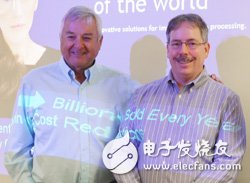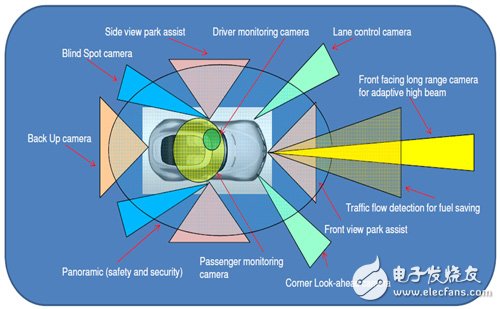Chip makers compete for smart car business opportunities. In order to increase the added value of products, European and Asian car manufacturers are competing to invest in smart vehicle research and development, and to develop new performance and specifications for relevant key components. Therefore, the semiconductor industry has all tried to make every effort to launch a solution to meet market demand. Improve the visibility of the market and win the favor of the first-class OEM customer base. Semiconductor suppliers are racing to grab the smart car market. Mercedes-Benz, BMW, Audi, Chrysler, Toyota, Honda, Ford and other major automobile brands have highlighted product differentiation. Smart car layout, and the requirements for new component performance and specifications for in-vehicle entertainment systems, advanced driver assistance systems (ADAS), etc.; in addition, countries have successively set new laws for driving cars to be equipped with car cameras to enhance driving safety. In the revamp of semiconductor components such as DC-DC converters, dedicated video processors, serializers/serializers (SerDes), and market demand, attracting chip vendors to compete in the flag market. DC-DC converter bridge car USB charging is more stable For applications such as targeting mobile devices that are interconnected with in-vehicle infotainment systems via universal serial bus (USB) cables, Maxim has developed a battery charging (BC) specification version 1.2 for USB 3.0 and USB 3.1. -DC converter, which allows car USB charging to charge tablet devices and even notebook computers, while enabling car entertainment systems with higher transmission rate functions, is expected to drive the BC 1.2 specification in the car entertainment market is increasingly popular. Figure 1 Ben Landen, senior business manager for Maxim Automotive Solutions, says drivers or passengers using mobile USB cables to charge mobile devices are no longer an option. Ben Landen (Figure 1), senior business manager of Maxim Automotive Solutions, said that mobile devices such as smart phones and tablet devices have become important entertainment devices in the back seat of the car. Not only must the USB transmission interface be interconnected with the car infotainment system to achieve data transmission. The purpose is also increasingly relying on USB to charge in the car. As a result, Maxim has introduced the MAX16984, an automotive DC-DC converter that incorporates the USB Charger Specification 1.2 Charger Emulator, which delivers up to 7.5 watts of power, allowing end consumers to access the USB via the car. Charge the digital camera in the car. To further meet the charging power required for products such as tablets and notebooks, and to increase data transfer rates, Maxim's new automotive-grade DC-DC converters will integrate BC 1.2 charger simulations that support USB 3.0 and USB 3.1 standards. In order to cater to the trend of charging and transmitting large amounts of data for various mobile devices through the USB cable in the car infotainment system. At present, the new product has been sent to the original equipment manufacturer (OEM) for testing. If the test passes, it is scheduled to be officially launched in 2015. It is understood that in the past, USB cables are prone to voltage drop and will reduce the charging current, resulting in the inability to properly charge portable devices, while low-cost portable USB car chargers are prone to radio frequency (RF) interference. In view of this, Maxim integrates DC-DC converter, USB BC 1.2 version charger (supports USB 2.0 standard) and USB protection switch, and is the first in the industry to release the highly integrated MAX16984, breaking through the above technology, while reducing product size and overall material. List (BOM) cost. Landen emphasized that automotive USB requires a unique protection solution that will be a new generation of BC 1.2 version of the automotive DC-DC converter supporting the USB 3.0 or 3.1 standard, which will meet the challenge of expected performance. The application for wireless charging in the automotive field is bullish, and Landen believes that the current technical solutions proposed by the three camps of the Wireless Charging Alliance (WPC), the Wireless Power Alliance (A4WP), and the Power Business Alliance (PMA), whether in consumer electronics, Mobile devices and the automotive market have low penetration rates, which are difficult to match the USB transmission interface, so it is estimated that USB will not pose any threat to the car charging market in the next few years. In addition to in-vehicle entertainment systems, smart car security systems will evolve from passive to active, accelerating automotive camera resolution and viewing angle specifications. Strengthen the specifications of the camera for driving safety vehicles In order to enhance driving safety and comfort, and to meet the requirements of the US Department of Energy's National Highway Traffic Safety Administration (NHTSA) and the European New Car Safety Association (Euro NCAP), the depot has increased the resolution of the car camera to 1,080p, and expand the range of viewing angles to 185 degrees. Figure 2 GEO Semiconductor Chairman and CEO Paul M. Russo (left) pointed out that the company's GW3 series of geometric processors have the advantages of adjustable pixels and low picture delay, which helps to improve the resolution of the camera and expand the viewing angle of the car camera. Into the first-class car camera OEM supply chain. Right is General Manager and Vice President John Casey Paul M. Russo, Chairman and CEO of GEO Semiconductor (pictured on the left), said that automotive brands continue to provide safer and more comfortable functional designs for driving, highlighting product differentiation and thereby increasing market penetration; The car camera has been regarded as an important development indicator, and is competing to increase the resolution and viewing angle specifications of the photographic lens. In addition, NHTSA and Euro NCAP are also making efforts to promote the adoption of car cameras to enhance driving safety. For example, NHTSA announced at the end of March 2014 that all new models under 10,000 pounds that were manufactured in May 2018 must be equipped with rear view. The use of Rear Visibility technology to enhance the safety of cars and reduce the casualties caused by car accidents is expected to drive the demand for car cameras to increase. John Casey, General Manager and Vice President of GEO Semiconductor (pictured right 2), pointed out that it is inevitable that the car factory will install eight cameras in a single car to enhance the active safety of its products (AcTIve Safety) with a car camera. Will grow to eleven (Figure 3), including Blind Spot Camera, Back Up Camera, Lane Control Camera, Driver Monitoring Camera, side view Side View Park Assist, Panoramic, Passenger Surveillance Camera, Corner Look-ahead Camera, Front View Park Assist, Traffic Flow Detection Camera (Traffic Flow DetecTIon) Camera) and the Front Facing Long Range Camera for AdapTIve High Beam. Figure 3 Application of a car camera to a smart vehicle Source: GEO Semiconductor Die-Casting Products,Led Die Casting,Pressure Die Casting,Aluminum Die Casting Led Yangzhou Huadong Can Illuminations Mould Manufactory Co., Ltd. , https://www.light-reflectors.com

